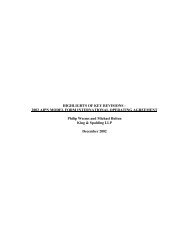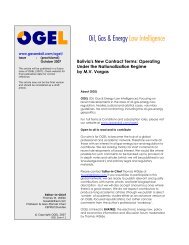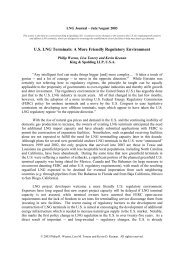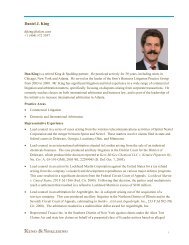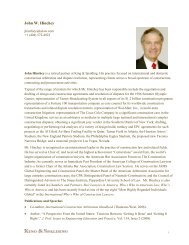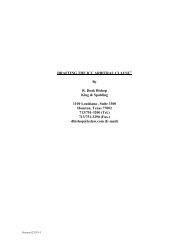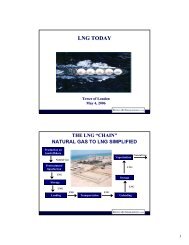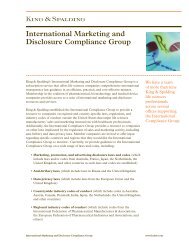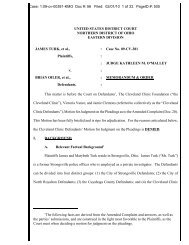Due Diligence Review: M&A Behind the Scenes - King & Spalding
Due Diligence Review: M&A Behind the Scenes - King & Spalding
Due Diligence Review: M&A Behind the Scenes - King & Spalding
Create successful ePaper yourself
Turn your PDF publications into a flip-book with our unique Google optimized e-Paper software.
LEGALduediligence<br />
A Guide for Successful<br />
<strong>Due</strong> <strong>Diligence</strong><br />
BY JOHN KEFFER AND MARK E. THOMPSON<br />
Conducting a thorough due diligence investigation in <strong>the</strong><br />
context of an acquisition is more important now than<br />
ever. In an era of shareholder activism, heightened scrutiny<br />
of boards of directors, and ever increasing disclosure obligations,<br />
companies cannot afford to make a mistake in an<br />
acquisition and take on unexpected liabilities. At <strong>the</strong> same time,<br />
acquisitive companies do not want to lose out on promising<br />
acquisitions by overburdening a potential target with diligence<br />
requests that run <strong>the</strong> risk of souring <strong>the</strong> deal. Executives, bankers,<br />
and lawyers must carefully balance <strong>the</strong>se considerations in order<br />
to close a deal successfully. In order to accomplish this goal, a<br />
due diligence investigation must be carefully planned and executed<br />
so that it is conducted efficiently with <strong>the</strong> least amount of<br />
unnecessary intrusion.<br />
While extremely thorough, in-depth due diligence investigations<br />
have been commonplace in <strong>the</strong> US for quite some time,<br />
<strong>the</strong>y have become increasingly more common in Europe over <strong>the</strong><br />
last several years as well. American companies have been forced<br />
to conduct thorough diligence investigations due, in large part, to<br />
potentially massive litigation, tort, and environmental liabilities.<br />
Not surprisingly, <strong>the</strong> recent corporate scandals in <strong>the</strong> US have<br />
resulted in <strong>the</strong> process becoming even more intensified. It is not<br />
uncommon in <strong>the</strong> US for <strong>the</strong> acquiring company to do its best to<br />
know just as much about <strong>the</strong> target’s liabilities as <strong>the</strong> target itself.<br />
This concept has begun to spread throughout Europe as well.<br />
This is <strong>the</strong> result not only of <strong>the</strong> proliferation of US investment<br />
bankers and lawyers in Europe, but also <strong>the</strong> recent European corporate<br />
scandals as well as shareholders generally holding managers<br />
more accountable for <strong>the</strong>ir acquisition decisions.<br />
The most critical element when planning a due diligence investigation<br />
is for <strong>the</strong> diligence team to understand <strong>the</strong> business<br />
objectives behind <strong>the</strong> acquisition. There is no o<strong>the</strong>r single factor<br />
that is more important in determining whe<strong>the</strong>r a due diligence<br />
exercise will be a success or a failure. This understanding will<br />
help <strong>the</strong> team prioritise <strong>the</strong> investigation and determine what<br />
information is important to review, when it needs to be reviewed,<br />
and, often more importantly, what can be skipped. For example,<br />
it is helpful for <strong>the</strong> diligence team to understand what business<br />
relationships are important for <strong>the</strong> target company’s business so<br />
particular attention can be given to contracts relating to that relationship.<br />
Similarly, if certain costs of <strong>the</strong> target are going to be<br />
eliminated following <strong>the</strong> transaction due to synergies and redundancies<br />
with <strong>the</strong> target, any contracts relating to those costs may<br />
only need to be reviewed for termination provisions. It may<br />
involve additional time and expense at <strong>the</strong> outset to educate <strong>the</strong><br />
diligence team as to <strong>the</strong> goals and objectives of <strong>the</strong> transaction,<br />
but it will invariably pay off over <strong>the</strong> course of <strong>the</strong> transaction.<br />
In connection with understanding <strong>the</strong> objectives of <strong>the</strong> transaction,<br />
<strong>the</strong> diligence team also needs to work with <strong>the</strong> business<br />
team running <strong>the</strong> transaction to reach a common understanding as<br />
to <strong>the</strong> work product <strong>the</strong>y expect <strong>the</strong> diligence effort to produce.<br />
The final work product produced at <strong>the</strong> conclusion of a due diligence<br />
exercise can vary widely, and no two are ever identical. On<br />
one end of <strong>the</strong> spectrum, <strong>the</strong> diligence team may be asked not to<br />
produce a long, detailed report, but ra<strong>the</strong>r only highlight problems<br />
that have been discovered ei<strong>the</strong>r with <strong>the</strong> target company<br />
itself or that may be faced during <strong>the</strong> integration process.<br />
Ironically, this can sometimes be <strong>the</strong> most difficult type of diligence<br />
assignment as it may result in outside counsel making<br />
almost all <strong>the</strong> decisions as to materiality independently from <strong>the</strong>ir<br />
client. On <strong>the</strong> o<strong>the</strong>r end of <strong>the</strong> spectrum, some companies prefer<br />
to receive a very detailed report, often hundreds of pages, that<br />
summarises in detail each and every contract. Most investigations<br />
end up somewhere in <strong>the</strong> middle. Frequently, a summary<br />
memorandum is produced highlighting <strong>the</strong> significant issues,<br />
while a more detailed backup memorandum is prepared in case<br />
<strong>the</strong> business people want to drill down on to any particular issue.<br />
Regardless of what kind of report is being produced, however,<br />
understanding <strong>the</strong> goals and objectives of <strong>the</strong> transaction, will not<br />
only aid <strong>the</strong> diligence team in providing a useful work product,<br />
but also allow <strong>the</strong> team to ga<strong>the</strong>r o<strong>the</strong>r information during <strong>the</strong><br />
investigation that may be asked of <strong>the</strong>m during <strong>the</strong> transaction<br />
even though it was not part of <strong>the</strong> scope of <strong>the</strong> original exercise.<br />
In some acquisitions, <strong>the</strong> acquiring company not only needs to<br />
conduct a due diligence investigation on <strong>the</strong> target, but it also<br />
may need to conduct a similar review of itself. This type of self<br />
examination is often overlooked, but can be exceedingly important<br />
not only with respect to synergies, but also potential damages<br />
to <strong>the</strong> company’s existing operations that may result from <strong>the</strong><br />
transaction. For example, in businesses where <strong>the</strong>re are exclu- <br />
www.financierworldwide.com | <strong>Due</strong> <strong>Diligence</strong> <strong>Review</strong>: M&A <strong>Behind</strong> <strong>the</strong> <strong>Scenes</strong> 2004 FW 11



